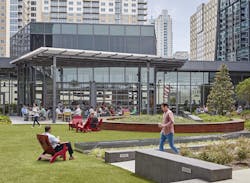Increasing the Function and Use of Outdoor Spaces for Commercial Workplaces
The pandemic made us all aware of the importance of outdoor air in our everyday lives, and working from home has provided us more opportunities to get outside and experience the benefits firsthand. As we contemplate returning to the office, clients and their employees are asking: How can we design outdoor environments that give us the health benefits of fresh air and connection to nature while also providing structured spaces that support productivity and collaboration?
Restorative Value
Research at the University of Minnesota and Harvard University validates that being in nature makes people feel better emotionally, improves overall physical wellbeing and positively effects health metrics such as blood pressure, heart rate and the body’s levels of stress hormones. We also see cross-over between the desires of our wellness clients and what occupants are looking for in design for the workplace.
Wellness projects such as the Student Health & Wellness Center at the University of Virginia present a collection of strategies for merging outdoors and indoors. Large windows allow views of nature. Circulation, orchestrated to align with those views, brings a sense of nature and natural light inside. Transitions between outdoor terraces and gardens are seamless, with no change in floor level. With the pandemic, our thinking has shifted to emphasizing health and wellbeing in all buildings.
Breaking the Workday
What used to be relegated to the ground level—generous setbacks, canopies, shade trees and integrated seating to provide office workers an outdoor break area—is moving up. Terraces, balconies, elevated gardens and other architectural outdoor spaces are appearing at all levels, from raised green spaces that connect towers, such as at NCR World Headquarters in Atlanta, to open-air levels above parking structures as at 405 Colorado in Austin and rooftop terraces like the one designed on the 38th story of Atlanta’s Fifty Ivan Allen tower.
The Republic in Austin and WestStar Tower in El Paso both take building setbacks to a new extreme, giving back large plaza space to the community while providing occupants open, comfortable lobby spaces that bleed into these public plazas. Both also include upper-level terraces for more private green space that give workers the option to move outside to collaborate, conference and focus.
At Twelve24 in Atlanta, outdoor spaces are directly adjacent to similarly programmed indoor spaces for an easy transition to inside or outside as needed—the gym extends to an outdoor fitness space and just outside the indoor conference center is an exterior meeting pavilion. The rooftop terrace is connected to the indoor employee dining space with an operable glass wall system. This is also true at NCR, where gathering and dining spaces spill from indoor to out. The design strategy of aligning similar indoor and outdoor functions ensures people can move easily between the two depending on weather conditions.
Design Challenges
A successful outdoor workspace, particularly on a building’s upper levels, hinges on more than access. Apple recommends an optimal temperature for their laptops falls between 50 and 95 degrees F., and glare can be problematic when working outdoors. Shade structures or shade trees are critical to making outdoor space usable during the workday.
For WestStar Tower and other new building designs, multistory terraces are carved into the building’s form to provide sun protection. At NCR, shade structures and overhangs create protected zones for individuals to work and meet.
Supplemental heating and cooling can extend the time of the year where terraces are comfortable. Wind must be controlled with higher railings, windbreak structures and step-backs from a building’s edge—all features that also improve users’ sense of safety. Acoustics are also a factor in designing outdoor offices. Planes flying overhead, traffic, wind and construction noise in urban areas can interfere with meetings. These sounds can also be the perfect white noise for completing “head-down” focus tasks.
[Related: 3 Ways to Meet the New Hybrid Work Model]
Providing staff an outdoor workspace—no matter where it’s placed in a building—also means adding infrastructure like power outlets, robust WiFi and exterior lighting. Laptops take precedence over desktop computers so that employees can move seamlessly from an indoor office to an alternative outdoor spot to accomplish their work.
Make It Flex
As many offices move to a hybrid model, workplace variables may change on a day-to-day basis, including the amount of people in the office, the distance needed between desks, the type of work being done or the type of equipment needed for hybrid meetings. Adaptability is a necessity of the hybrid work environment. Furniture and workstations need to be reconfigurable depending on the current needs. Furniture that is easily moved, whether lightweight or on wheels, is desirable when adapting the space to fit individual needs. Hybrid workspaces with large folding walls, like the rooftop terrace at Twelve24, can also offer flexibility and access to the outdoors when desired.
For many of us, work-from-home has occurred on a couch, at the kitchen counter, on a screen porch or sitting in bed. More often, this was dictated by comfort. Everyone defines comfort in different ways, which makes including moveable, flexible and comfortable seating options as important outdoors as it is inside.
We can design for employee choice in the workplace by providing varying work environments that encourage employees to pick where they want to work. Imagine choosing where to work at the office for the day based on your to-do list. Providing options such as team conference rooms, independent focus zones, comfortable lounge areas or outdoor patio areas, either for individuals or as team spaces, could make returning to the office feel safe and desirable.
Material Thinking
Outdoor spaces require different materiality considerations, especially for exposure to sun and moisture. Wood is a popular choice for outdoor furniture. Hardwoods, like teak, are ideal for outdoor settings because they are more durable and weather resistant than soft woods. However, all wood requires proper treatment and maintenance to resist splintering or weathering over time. Many clients opt for powder-coated metal furniture for outdoor spaces because it’s durable, strong and easy to clean. Upholstered furniture and screenings, such as awnings and sunshades, must be resistant to sun fading, moisture and other damage caused by the outdoor elements.
Scaling Up
We see a trend toward larger spaces. Office occupants want spaces large enough to have corporate parties, fitness classes, and safely hold large gatherings in the fresh air. At Twelve24, two terraces account for nearly 25,000 square feet. For smaller outdoor spaces, large folding walls give the impression of a larger outdoor room, such as at the sky lobby of 405 Colorado. We often create furniture test-fits, along with wind and solar studies, for these spaces to illustrate strategies to ensure year-round use.
Here to Stay
The last year has reset many conventions and expectations of the workplace. As we return to the office, many of the discoveries made and lessons learned will stay with us. Ready access to outdoor spaces at work are more than something we need to integrate now—these spaces are vital tools to reshape, redefine and design the workplaces of our future.
About the Author:
Jane Bamford, AIA, is a senior associate at Duda|Paine Architects in Durham, North Carolina. Claire Miller, AIA, is an associate, and Meg Meredith is an interior designer.
Read next: The Magic of Water Features in a Post-COVID World
About the Author

firstName lastName
i+s partners with design practitioners and other industry experts to deliver informative and engaging content on a variety of topics related to commercial interior design, from the latest trends, research and technology to innovative projects, products and educational CEUs. Interested in becoming a contributor? Contact us today!
